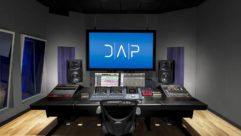In a world of incredibly sophisticated audio and video systems where any form of signal manipulation, editing, transmission and reproduction is possible, we still suffer from extreme problems in executing all of these functions without producing additional distortion and artifacts because of the real-world effects on our systems.
One of the difficulties that the audio and video industries face as a whole is that designers of electronic equipment work in the sterile environment of their laboratories and factories. The people designing the equipment are not those designing the systems that are being installed into the theaters, churches, recording studios, concert halls, broadcast facilities and audiovisual facilities. The equipment they design often tests perfectly in the laboratory and seems to have all of the input-output and internal wiring considerations necessary to provide signal integrity through the device. However, when this equipmetn9s installed in the real world, the performance of the overall system is less than one might expect based on the performance of the individual components.
In recent times, particularly through the AES, there has been a great deal of finger pointing. A number of system designers, including myself, have taken the time to document the problems that we must deal with because of the inadequacies of the electronic equipment used in our systems.
It appears that headway is being made and manufacturers are becoming more receptive to the problems that people designing, building and using audio-video systems are experiencing.
The reason this is important is that grounding and shielding systems alone will not provide guaranteed freedom from noise problems. The success of the grounding and shielding system depends on other factors in the system.
Achieving the right level of hardware installation to optimize the system performance and to minimize the cost of the installation must be done with a clear head and a knowledge of the issues that affect the noise in the audio of video system. T is easy to over-design and spend a lot of time with installation procedures that have little impact on the system’s freedom from noise.
A Systems Approach
The complexity of the problem of noise in audio and video systems requires an organized, methodical approach to control or minimize its effects. The problem of noise in electronic signaling is universal and affects the computer, aerospace and manufacturing industries, as well as the audio and video industries. The problem that we all face with regard to noise in signal systems is referred to as electromagnetic interference (EMI). EMI is a well-studied and documented science, and the problems of solving these types of system inadequacies are well-developed. There are several excellent texts on the subject (Ott, 1998; Morrison, 1986; IEEE, 1982).
It is possible to break down the problem of EMI into a number of individual components that can be studied and dealt with one at a time at the concept development, design, installation and testing phases of any audio or video system. This systems approach to dealing with EMI is an effective and efficient means of attacking these problems. The following section, an EMI refresher, will help systematize the ideas that are used in understanding and resolving EMI problems.
An EMI Refresher
For EMI to occur, three elements must be present:
-a source of electromagnetic noise (any electrical device).
-a transmission medium for the electrical noise to propagate in.-a receiver sensitive to the nature of electrical energy radiated by the source.
When each of these three elements exists, the performance of the receiver, often referred to as the victim, might be adversely affected.
When this shortcoming exists, EMI can be controlled a number of ways. The trick in the proper design of any audio or video system is to select the means of control that will most effectively deal with the problem without incurring undue cost. A select number of techniques can be used in our quest for an Emi-free world, and these are discussed in the following section.
Specifically, electrical noise has four means of transmission. It is important to identify how the noise is being transmitted to the receiver: this is a key factor in determining how it can be easily and effectively controlled.
The first form of transmission, common impedance coupling, occurs when a shared conductor (wire) is between the source and the victim. This is obviously the case between any two pieces of equpment9ardwired together, be it through signal lines or ac power or ground lines. (See Figure 4.)
The next form of transmission is electric field coupling. The model of an electric field emanating from a wire is shown in Figure 1. This type of coupling is determined by the capacitance between the source and the receiver. It is proportional to the area that the source and the receiver share between each other, the frequency and amplitude of the noise voltage, and the permitivity of the medium between the source and the receiver. It is inversely proportional to the square of the distance between them. Electric field coupling is a function, then, of the voltage of the source, and it creates a voltage in the victim conductors.
The third form of transmission is magnetic field coupling. The model of a magnetic field emanating from a wire is shown in Figure 2. This type of coupling is determined by the mutual inductance between the source and the receiver. It is a positive function of the loop area of the receiver circuit, the frequency and current of the source, and the permeability of the medium between the source and the receiver. It is inversely proportional to the square of the distance between them. Magnetic field coupling, then, is a function of the current of the source, and it creates a current in the victim circuit.
The final form EMI transmission, electromagnetic radiation, occurs when the source and the receiver are at least one-sixth of a wavelength apart, placing the receiver is what is known as the far field. The far field is defined as the distance away where the wavefront is a plane and the ratio of the electrostatic and electromagnetic field strength is a constant (equal to 377). An example of electromagnetic radiation is radio frequency interference (RFI) caused by radio stations, CBs and other high-powered transmitters.
A number of well-established techniques can be used to control EMI. One of the most common techniques is shielding. As the name implies, shielding consists of placing a conductive material between the source and the receiver. It can be done close to the source or the receiver. It is a common technique; for example, most audio and video cables have a conductive outer covering.
Another method is to use balancing and twisting. Balancing refers to inputs and outputs of electronic equipment that have both an in-polarity and an out-polarity signal. Twisting refers to the twist in the interconnecting wire between balanced inputs and outputs.
Together, these two techniques provide substantial EMI immunity in interconnections. Twisting reduces magnetic pickup almost completely by reducing the loop area of the cable to zero. Twisting the wires causes electric fields to induce common-mode signals on the wire. Because a balanced system allows only differential mode signals to pass through, these common-mode signals are therefore rejected.
Separation and routing can also be used. With proper separation and routing, the effect of the EMI source on the victim can be reduced by the simple fact that the strength of the EMI is reduced with distance. Therefore, careful separation and routing of audio and video cables and the electronic equipment from noise sources is a simple and effective means of reducing EMI problems. The field strength for a point source drops 6 dB per doubling of distance; a line source drops 3 dB per doubling of distance.
A common and successful technique is isolation. Anytime a conductor is between a noise source and a victim, there is a great opportunity for EMI via common impedance coupling. Isolation reduces EMI by providing electrical isolation between the two. Isolation is typically provided by transformers, by opto-isolators or, more recently, by fiber optic connections.
Another technique—grounding and bonding—consists of using conductive connections between equipment (bonding) and between equipment and the earth (grounding). The effects of this are twofold. The connection to the earth provides an infinite sink for the electromagnetic energy, which keeps all of the equipment connected to the ground at a stable potential. The effect of bonding keeps the equipment bonded together at the same potential. Bonding alone can be very effective. Bonding and grounding connections must be of very low resistance to avoid common impedance coupling.
When to ground and to what extent
It is difficult to know the trade-offs among shielding, balancing, separation, isolation and grounding. In countless installations, particularly in the recording studio industry, substantial efforts have been made to install grounding systems of extremely low impedance. These extreme measures are often taken to obtain the last ounces of performance from the audio systems. In small systems, the expense associated with going to these extreme measures is not large, and consequently it is not a big issue as to whether these measures were really required. Often it may be more of a point of pride with the studio owner or builder with regard to the rigorousness of his grounding system. However, in larger installations or more cost-sensitive ones, the necessary degree of complexity and robustness of the grounding system may be more of an issue.
Depending on the system’s architecture, it might be easier to use isolation techniques, such as balancing transformers, to obtain the necessary results. As audio and video equipment improve and input and output interconnections become more robust, the need for grounding systems will diminish.
Shielding and grounding are only two of many means available for controlling EMI. The effectiveness of shielding is normally determined by the designers of the equipment being used, such as the cable, the equipment racks, the electronic equipment cases and so on. Systems designers have little control over most of these items, other than by proper selection of the wire, racks and equipment. Grounding, where it pertains to large systems, is very much under the control of the system designer and the installers, and it is an area where proper application of good engineering principles can result in benefits.










